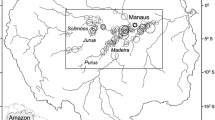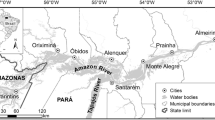Synopsis
The morphology, climate and flood regime of the Cross River floodplain are summarized and related to the catch, species distribution and abundance of the economically important fishes of the floodplain ecosystem. Two flood indices, FI-1 and FI-2, are used to assess, statistically. the relationship between fish catch and flood regime. There are good positive correlations between the catch (CT) of year T and the flood index 1 of 1 year T-1 and between (CT) and the sum of the flood indices 1 and 2 of year T-1 (r = 0.6516 and 0.6894, respectively, both at P = 0.05). Cross River is a relatively highly productive system (in terms of fish catch) and this productivity is attributable mainly to the yearly flooding of the plain when fish find allochthonous food materials in the expanded habitat. Changes in hydrometeorological conditions, such as the drought that affected the northern part of the Cross River basin in 1983–1984. if they persist can effectively reduce fish catch from the system.
Similar content being viewed by others
References cited
Awachie, J.B.E. & L. Hare. 1978. The fisheries of Anambra, Ogun and Oshun river systems in Southern Nigeria. pp 170–184.In: Symposium on River and Floodplain Fisheries in Africa, CIFA Tech. Pap. 5. 378 pp.
Beadle, L.C. 1981. The inland waters of tropical Africa. Longman, London. 475 pp.
Campbell, R.C. 1967. Statistics for biologists. Cambridge University Press, Cambridge. 242 pp.
Daget, J. & A. Iltis. 1965. Poissons de Cte d'Ivoire. Mem. I.F.A.N. 74: 1–385.
ENPLAN (Consultant Engineers) 1974. Cross River basin prefeasibility report. Federal Ministry of Agriculture, Lagos (Nigerian Federal Government publication).
Erborge, A.B.M. 1972. The physical hydrology of the river Oshun, Nigeria. Arch. Hydrobiol. 70 72–81.
Etcheri I.E. & P.E. Lebo. 1983. A synopsis of traditional gear in use in artisanal fisheries along the upper part of the Cross River. pp. 159–170.In: Proceedings of the 2nd Annual Conference of the Fisheries Society of Nigeria (FISON), Kainji Lake Research Institute, New Bussa.
Gerking, S.D. 1977. Freshwater fish — a global food potential. Ambio 6: 39–43.
Halyk, L.C. & E.K. Balon. 1983. Structure and ecological production of the fish taxocene of a small floodplain system. Can. J. Zool. 61: 2446–2464.
Hamley, J.M. 1980. Sampling with gillnet. pp. 37–53.In: Guidelines for Sampling Fish in Inland Waters, EIFAC Tech. Paper 33: 00–00.
Henderson, H.F. & R.L. Welcomme. 1974. The relationship of yield to morpho-edaphic index and numbers of fishermen in African inland fisheries. CIFA Occas. Pap. 1: 1–19.
Holden, J.M. & J. Green. 1960. The hydrology and plankton of the river Sokoto. J. Anim. Ecol. 29: 65–84.
Holden, M.J. & J. Green. 1963. The population of fish in dry season pools of the river Sokoto. Fisheries publication of the Colonial Office, London 19: 1–58.
Johanson, K. 1974. Air breathing fishes. pp. 138–147.In: Vertebrate Structure and Functions — Readings from Scientific American, Freeman and Company, San Francisco.
Lowe-McConnell, R.H. 1975. Fish communities in tropical freshwaters. Longman, London. 337 pp.
Moses, B.S. 1979. The Cross River, its ecology and fisheries. pp. 355–371.In: Proceedings of the International Conference on Kainji Lake and River Basins Development in Africa, Kainji Lake Research Institute, New Bussa.
Ryder, R.A. 1965. A method of estimating the potential of fish production in north temperate lakes. Trans. Amer. Fish. Soc. 94: 214–258.
Rzoska, J. 1974. The Upper Nile swamp: a tropical wetland study. Freshwat. Biol. 4: 1–30.
Watson, J.D. & E.K. Balon. 1984a. Ecomorphological analysis of fish taxocenes of rainforest streams of northern Borneo. J. Fish Biol. 25: 371–384.
Watson, J.D. & E.K. Balon. 1984b. Structure and production of fish communities in tropical rainforest streams of northern Borneo. Can. J. Zool. 62: 927–940.
Welcomme, R.L. 1975. The fisheries ecology of African flood-plains. CIPA Tech. Pap. 3: 1–51.
Welcomme, R.L. 1976. Some general and theoretical considerations on fish yield of African rivers. J. Fish Biol. 8: 351–364.
Welcomme, R.L. & H.F. Henderson. 1976. Aspects of the management of inland waters for fisheries. FAO Fish. Tech. Pap. 161: 1–36.
Author information
Authors and Affiliations
Rights and permissions
About this article
Cite this article
Moses, B.S. The influence of flood regime on fish catch and fish communities of the Cross River floodplain ecosystem, Nigeria. Environ Biol Fish 18, 51–65 (1987). https://doi.org/10.1007/BF00002327
Received:
Accepted:
Issue Date:
DOI: https://doi.org/10.1007/BF00002327




